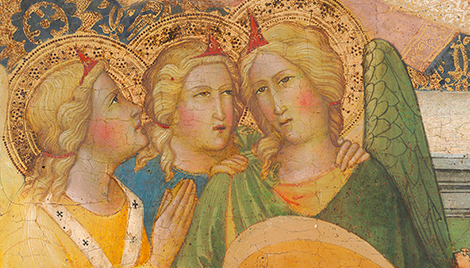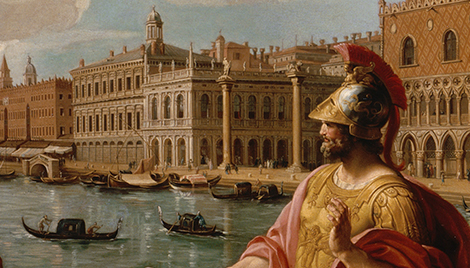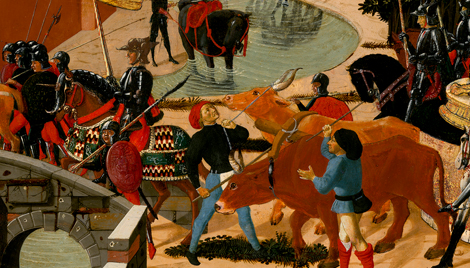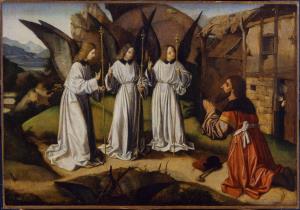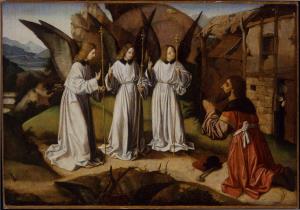Abraham and the Three Angels
Abraham and the Three Angels
- Artist
- Josse Lieferinxe
- Artist Dates
- died before 1508
- Artist Nationality
- French
- Title
- Abraham and the Three Angels
- Date
- about 1495-1500
- Medium
- oil on panel
- Dimensions
- 45.9 x 66.6 cm (18-1/8 x 26-1/4 in)
- K Number
- K367
- Repository
- Denver Art Museum
- Accession Number
- 1961.158
- Notes
Provenance
Vicomte Bernard d' Hendecourt, Paris and London. [1] (Anonymous sale, Sotheby's, London, 9 May 1934, no.136 as Attributed to Antonello da Messina); (Guiseppi Bellesi, London). [2] (Count Alessandro Contini Bonacossi [1878-1955] Rome-Florence); sold to Samuel H. Kress [1863-1955] on 10 October 1935 as Antonello da Saliba; gift to the National Gallery of Art in 1939; deaccessioned in 1952 and returned to the Samuel H. Kress Foundation; gift to Denver Art Museum, no. 1961.158. [1] A painting of this subject was offered at the d'Hendecourt sale at Sotheby's, London, 8 May 1929, no. 110 as Italian School, Angels in the House of Abraham. The dimensions in the sale catalogue do not match those of the Denver picture, but given the unusual subject and the association of the Denver picture with Hendecourt, a dealer in Paris also associated with Durlacher Brothers, London, it is possible that the picture in the 1929 sale is that now in Denver. [2] Printed buyer list insert gives the buyer as Bellisi, but this is almost certainly a misspelling and refers to the dealer Guiseppi Bellesi who was active in London at that time and often sold to Contini.
Catalogue Entry
Josse Lieferinxe
Abraham and the Three Angels
K367
Denver, Colorado, Denver Art Museum (E-953), since 1954. Tempera on cradled lindenwood. 18 1/8 x 26 1/4 in. (46.1 x 66.7 cm.). Several linen patches were attached to the lindenwood support of K367 prior to painting. Cut down at left, bottom and top. Extensive worm-tunneling. Two vertical joins, through angel at left and angel at center.(1) Recradled, cleaned and restored by Pichetto in 1936. Slight restoration by Modestini in 1954; in a fair state of preservation. Denver, p. 18, Cat. No. 5. Abraham kneeling in left profile at the lower right (his hat and stick on the ground) looks toward three standing angels in identical garb, each of whom holds a staff in one hand and points upward with the other. They announce that Abraham's aged wife Sarah, seen standing at the door of a dilapidated farmhouse at the right, will give birth to a son (Genesis 18:1-16). Sheepskins dry on the roof above a haystack to the left. Sheep graze on the steep hills behind the angels. The semicircle cut off by the left border is the right end of a table.(2) A river winds through a valley to the left. The upper half of a winged heart-shaped object (gourd?) hangs from a tree stump in the foreground.(3) As noted by Sterling, the winged form may be emblematic.(4) The Kress panel is based upon a composition, presumably by the young Antonello da Messina, known through two examples. The first (Reggio Calabria, Museo della Magna Grecia), possibly painted by Antonello himself, fragmentarily preserved and in poor condition, shows the three angels and a landscape section to the left which includes a round table. The panel measures 21.4 x 29.3 cm.(5) The second is a copy, possibly a pastiche, by a Sicilian imitator of Antonello da Messina, at Forza d' Agrò (Chiesa della Triave); it shows the three angels seated at a circular table with Abraham kneeling at the lower right.(6) In 1935 Venturi ascribed K367 to Antonello de Saliba noting that the panel provided a reconstruction of the fragmentarily preserved painting by Antonello da Messina in Reggio Calabria.(7) Roberto Longhi, William Suida, and F. F. Mason Perkins followed Venturi's views.(8) A Flemish element was detected in K367 by Van Marle who attributed the panel to the early Antonello da Messina, rather than to his follower, whom he did not find to have been influenced by northern art.(9) In the early 1930s Fiocco viewed K367 as the work of a Lombard painter, superior in talent to de Saliba, based upon an early panel by Antonello da Messina (Reggio Calabria).(10) Berenson observed that the Kress panel was probably by Francesco Napoletano, based upon the depiction of three angels (Reggio Calabria) by Antonello da Messina or Antonio de Saliba.(11) The panel was attributed to Antonio de Saliba by Burroughs who found the subject rare in Italian art and the painting reminiscent of northern art. He related the angels to those painted on the vault of the Hôtel Jacques Coeur at Bourges and described the landscape as reminiscent of those by Simon Marmion.(12) K367 is labeled by Bottari as a Lombard copy after Antonello.(13) According to Lauts, it is an old copy, possibly by a Lombard imitator of Antonello da Messina based upon the work by Antonello at Reggio Calabria.(14) In 1941 the panel was attributed to Antonello de Saliba.(15) The panel was attributed to the French Master of St. Sebastian Gosse Lieferinxe) by Ragghianti. The Italian scholar placed the work between Lieferinxe's Pieta (Antwerp, Musée des Beaux-Arts) and the St. Sebastian panels which he viewed as from the master's last period of c. 1500 when he was much influenced by Italian painting, becoming a 'Provencal Bramantino'.(16) The compositional source for AbrahamVisited by Three Angels was given by Bottari as Eyckian, perhaps by Petrus Christus. He found the Kress panel to be a Lombard or Provencal replica of Antonello's lost source, noting that the attire of Sarah and the Alpine landscape were not Italian, the angels recalling the one by Petrus Christus in the Annunciation (Berlin, Staatliche Museen).(17) The Denver catalogue (1954, p. 18, Cat. No. 5) gave K367 to a 'close pupil of Antonello da Messina ... possibly painted by Antonello de Saliba.' According to Laclotte the Kress panel was painted in Lombardy c. 1490, close in style to the Master of St. Sebastian.(18) Sterling believed the painting to be copied by Josse Lieferinxe, after Antonello's depiction of the same subject. He showed the face of Abraham to be identical with that of one of the archers from St. Martin and the Archers (Philadelphia, Philadelphia Museum of Art, Johnson Collection).(19) He suggested that the winged object hanging from the 'arbre sec' in the foreground might be a bellows or an escutcheon, possibly a device analogous to that of Louise de Savoie.(20) Castelfranchi Vegas catalogued the panel as by a 'Provencal painter (?) c. 1490', a faithful copy of Antonello's work of the same subject.(21) In Western typology the subject of the Annunciation to Abraham was viewed as a prefiguration of the Annunciation to the Virgin. The long narrow proportions of the Kress panel suggest that it may have functioned as a predella, placed in close proximity to the Marian scene. Although the composition resembles that of Antonello da Messina, the latter need not be its forerunner. Northern art, drawn upon extensively by Antonello for his own work, might also have provided the compositional source.(22) Provenance: Viscomte Bernard de' Hendercourt (?).(23) Sale, London, Sotheby's, 9 May 1934, the property of a deceased nobleman, p. 27, Cat. No. 136, attributed to Antonello da Messina. Florence, Contini Bonacossi. Kress acquisition 1935, exhibited –Washington, D.C., National Gallery of Art, Preliminary Catalogue, 1941, p. 8, Cat. No. 315.
References
(1) Both Carlo Ragghianti ('Bordeaux-Genova', review of the exhibition Primitivi Mediterranti, Bordeaux-Genova, 1952; Sele Arte, I, Sept.-Oct. 1952, p. 79) and Charles Sterling (op. cit. Note 1 above, p. 16, n. 52) have noted that K367 is poorly restored. The bird at the lower left was originally a snail. (2) Sterling, op. cit. Note 24 below. (3) For the iconography of the subject see Réau, II, I, p. 131. See also Karl Möller, 'Abraham IV', Reallexikon zur deutschen Kunstgeschichte, I, cols. 89-92. (4) For winged hearts see Arthur Henkel and Albrecht Schone, Emblemata, Stuttgart, 1967, col. 1027. (5) For the restoration of the Reggio Calabria panel see Paolo della Pergola, 'Le tavolette antonelliane di Reggio Calabria', Bolletino d'Arte, XXXI, 3rd series, 1938, p. 515; also Antonello da Messina e la Pittura del 1400 in Sicilia, Messina, 1953, pl. II. (6) First published by Stefano Bottari, 'Ricerche intorno agli Antonelliani', Bolletino d'Arte, I, 2nd series (XXIV), 1931, p. 309, fig. 14, ascribed to 'Jacobello d'Antonio (?)'. The Forza d'Agrò panel is by Antonino Guiffré (Liana Castelfranchi Vegas, 'I rapporti Italia-Fiandra', Part 2, Paragone, n.s. 21, XVII, no. 201, 1966, pp. 42-69, esp. p. 52.). (7) Kress Archive. (8) Ibid. (9) Ibid. (10) Ibid. (11) Ibid. (12) Ibid., c. 1933. (13) Stefano Bottari, 'Il primo Antonello', Critica d'arte, IX, 1937, pp. 97-109 (opposite p. 101, pl. 81, fig. 3). (14) Jan Lauts, Antonello da Messina, Vienna, 1940, p. 34, Cat. No. 10. See also his 'Antonello da Messina', Jahrbuch der kunsthistorischen Sammmlungen in Wien, n.s. VII, 1933, pp. 15-88. (15) Preliminary Catalogue, National Gallery of Art, Washington, D.C., 1941, p. 8, Cat. No. 315. (16) Ragghianti, op. cit. Note 6. (17) Bottari, Antonello, Milan-Messina, 1953, p. 14. (18) Michel Laclotte, L'École d'Avignon, Paris, 1960, p. 123, n. 67; p. 100. (19) Sterling, op. cit. Note 24 below, pp. 14 ff., figs. 31, 30. (20) Sterling, op. cit. Note 29 below, p. 16, n. 52. Louise's device is reproduced by Guy de Tervarent, Attributs et symboles dans l'art profane, 1450-1600, I, 1958, fig. 2. (21) Castelfranchi Vegas, op. cit., p. 5, pl. 41b. (22) The predella format is rarely found in Northern European altarpieces but Lieferinxe is known to have been employed upon a retable utilizing this convention (The Pieta of the Retable de Saint Sebastien, Antwerp, Musée des Beaux-Arts). As Lieferinxe worked with an Italian artist, Bernardino Simondi, the latter may have familiarized him with the Italianate form which is also encountered in Provence. (23) Mason Perkins, loc. cit., described K367 as having been discovered 'c. 1915' by de' Hendercourt. (24) See Egbert Haverkamp-Begemann, 'Een onbekend werk van Meester van de Hl. Sebastian', Bulletin des Musées Royaux de Belgique, VII, 1958, pp. 18-28, and Charles Sterling, 'Josse Lieferinxe peintre provencal', La Revue du Louvre et des Musées de France, XIV, 1964, pp. 1-2.

